Kwai Tsing Container Terminals operator acknowledges need for port players to shape up or ship out, with alliance offering hope that they can deliver.
An alliance of players in Hong Kong’s port is eyeing refrigerated facilities as an edge over fierce competition from mainland China, with the group seeking to regain its lost crown as the world’s busiest shipping hub.
An example of this efficiency at play is how a container of freshly harvested Chilean cherries can arrive at the city’s Kwai Tsing Container Terminals and be distributed at wholesale markets in Guangzhou within five hours.
According to Modern Terminals Limited (MTL) group managing director Horace Lo Wai-man, this was possible after all but one terminal operator banded together and coughed up a capacity of more than 7,800 refrigerated containers, twice that of rivals in southern China.
“From going through customs inspection to a truck’s arrival at Guangzhou, it takes 4½ hours,” he said in an interview with the Post. “In China, it takes a few hours alone for customs clearing.”

The Hong Kong Seaport Alliance was not without controversy, however. Last October it addressed concerns of the city’s antitrust watchdog, the Competition Commission, by putting in place commitments to ensure a level playing field at the port.
The alliance came under investigation because MTL, Hongkong International Terminals, COSCO-HIT Terminals (Hong Kong), Asia Container Terminals jointly operate and manage their 23 berths across eight terminals at the Kwai Tsing port. The fifth operator Goodman DP World is not part of the alliance.
Lo said the competition with mainland ports over cold-chain services was punishing even though the business was seasonal.
“The Chinese ports in the region are looking at this business, if Hong Kong falls behind in efficiency, the business may go to their ports,” he said. “Hong Kong is the first port in the Pearl River Delta when a ship comes in. If it has to go further north, it will take an extra few hours.”
Hong Kong was ranked No 8 in 2019 among the world’s busiest ports after falling for the first time out of the top five in 2018.
About HK$3 billion worth of produce is shipped annually to Kwai Tsing. Of this, 60 per cent is transported to the mainland, according to Lo. According to the Census and Statistics Department, the city’s imports by sea dropped 13 per cent in 2019 to HK$611 billion, exceeding the overall contraction of 6.5 per cent in general imports.
Lo said products commonly shipped in by sea included durians from Thailand, cherries from Chile, kiwis from Australia as well as a range of fruit from Asian countries.
In the first nine months of 2020, there was a 48 per cent jump in durian imports, to 27,000 20-foot equivalent units (TEU) handled by the alliance, compared with the same period last year, Lo added.
Lo expected a slight growth in imports of Chilean cherries, which took 22 days to get to Hong Kong, and recorded an 8 per cent jump to 18,000 TEU during the last season between December 2019 and May 2020.
“More than 80 per cent of Chilean cherries shipped to Hong Kong’s port were sold in China,” Lo said of the last season.

He added that higher port call frequencies by ships in Hong Kong made the city more competitive. For example, there were more than 30 weekly calls between Thailand and Hong Kong, which helped boost durian shipments from Southeast Asian countries by 35 per cent in the first eight months of this year. And most of the fruit was distributed across the border.
Leo Lai, general manager of fruit importer and retailer Tung Shing Fresh Fruits, said the company primarily brought in the produce such as Japanese apples and peaches by sea and found the Kwai Tsing port more efficient.
“There are more ships calling on the Hong Kong port than to other ports in southern China, which means I can pick up the fruits faster, put them on the market sooner and hence sell them at higher prices,” he said. “For fruits with a shorter shelf life, we will fly them in.”
Henry Yeung, a co-founder of fruit importer and retailer Dr Fruits, which uses air freight more often, said the company imported pears and apples from Japan. The voyages normally took about four days.
“Hong Kong port’s infrastructure is relatively more sophisticated. Even when containers are offloaded at the Hong Kong port, refrigeration is still available,” he said.















